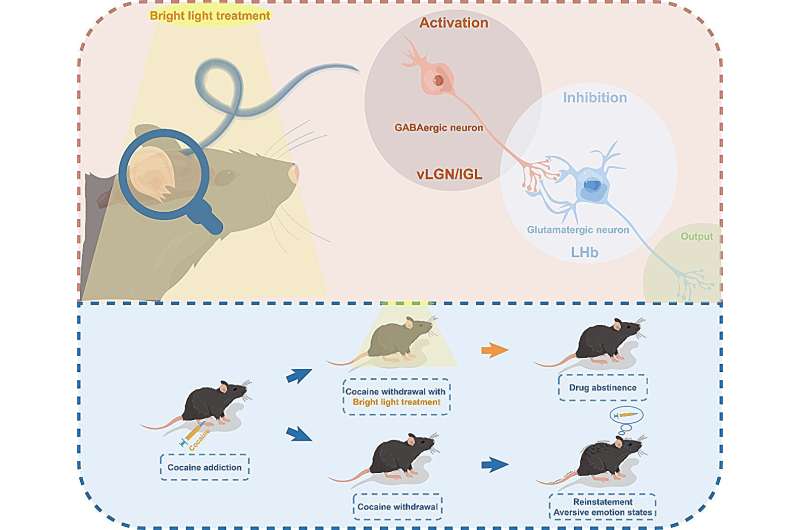This article has been reviewed according to Science X's editorial process and policies. Editors have highlighted the following attributes while ensuring the content's credibility:
fact-checked
trusted source
proofread
A visual circuit related to the habenula mediates the prevention of cocaine relapse by bright light treatment: Study

The treatment of drug addiction remains a significant challenge, with cocaine use disorder (CUD) carrying a high rate of relapse and imposing a significant global burden.
Over the past few decades, considerable efforts have been made to increase the effectiveness of extinction training, a method where individuals are repeatedly exposed to drug-related cues without actual drug use. These efforts have bolstered earlier reports that support the potential for interventions during drug withdrawal with extinction training to prevent relapse.
The lateral habenula (LHb) is particularly noteworthy as it is responsible for driving aversive emotional states, cognition, and withdrawal effects from cocaine. Previous studies have found that the LHb underlies the non-visual aspect of bright light treatment (BLT) in modulating aversive emotional states.
Activation of the ventral lateral geniculate nucleus and intergeniculate leaflet (vLGN/IGL)-LHb pathway by BLT can modulate LHb neuronal excitability and fire mode switching. Considering that aversive emotional state is a significant driver of relapse, it is conceivable that light-based modulation of LHb neuronal activity could influence CUD-related symptoms, particularly relapse.
This study, led by Prof. Chaoran Ren (Guangdong-Hongkong-Macau Institute of CNS Regeneration, Jinan university), Prof. Tifei Yuan (Shanghai Mental Health Center, Shanghai Jiaotong University School of Medicine), and Prof. Song Lin (Department of physiology, Jinan university), investigated the effects and underlying circuit mechanisms of BLT during cocaine withdrawal with extinction training on relapse-related reinstatement.
Yunwei Fu et al. began by mapping the brain network active during cocaine withdrawal using the neuronal activity marker c-Fos. They found a progressive potentiation of LHb neuronal activity during cocaine withdrawal. Subsequently, they found that BLT administrated during cocaine withdrawal ameliorates LHb neuronal activity, cocaine-driven reinstatement and the aversive emotional states.
To elucidate the neuronal circuitry underlying the effects of BLT on cocaine-driven reinstatement, the team focused on the vLGN/IGL-LHb pathway using various brain circuit analysis tools, including ex vivo electrophysiological recording, fiber photometry ,and chemogenetics. They revealed that the effects of BLT were mediated by activating LHb-projecting neurons in the vLGN/IGL or by inhibiting postsynaptic LHb neurons.
In summary, the team uncovered the non-visual function of light in modulating relapse-related reinstatement after cocaine withdrawal, with and without extinction training, offering a promising avenue for the use of light-based therapy in the treatment of drug addiction.
The paper is published in the journal Science Bulletin.
More information: Yunwei Fu et al, A visual circuit related to the habenula mediates the prevention of cocaine relapse by bright light treatment, Science Bulletin (2023). DOI: 10.1016/j.scib.2023.08.010




















